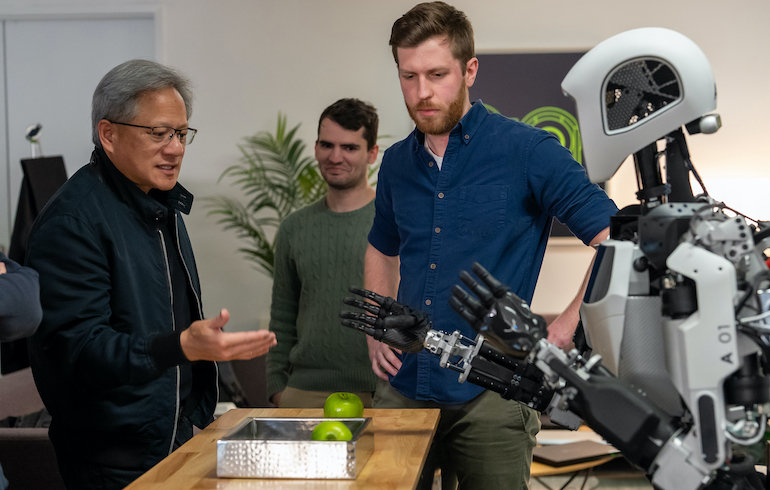|
Listen to this article  |

NVIDIA CEO Jensen Huang (left) with the Apollo humanoid robot. Source: Apptronik
SAN JOSE, Calif. — Among the highlights of GTC this week was the convergence of artificial intelligence and humanoid robotics. Apptronik Inc. announced that it working to integrate its Apollo humanoid robot with Project GR00T, NVIDIA Corp.’s new general-purpose foundation model for robot learning.
“The world is designed for humans — so it makes sense that humanoid robots are the type of robot best equipped to navigate, adapt, and interact with it,” said the Austin, Texas-based company. “Furthermore, humanoid robots comprise the ideal hardware for learning general-purpose skills by observing human demonstrations.”
“The combination of Apollo and Project GR00T will enable developers to take text, video, and human demonstrations as task prompts, learn generalizable skills like coordination and dexterity, and generate actions as output on the robot hardware,” Apptronik asserted. “Instead of simply repeating the actions in the training data, Apollo will recognize the environment and predict what to do next to achieve its goal.”
Apptronik said it is working to make possible a future where humanoid robots improve how people live and work. In his GTC keynote, NVIDIA CEO Jensen Huang included an example of this type of learning. He showed how Apollo, through its integration with the GR00T foundation models, learned how to autonomously operate a juicer and serve juice.
 Learn from Agility Robotics, Amazon, Disney, Teradyne and many more.
Learn from Agility Robotics, Amazon, Disney, Teradyne and many more.
Apptronik iterates humanoid robot design
Apptronik spun out of the Human Centered Robotics Lab at the University of Texas at Austin in 2016. The company‘s stated mission is to use innovative technology for the betterment of society. It added that Apollo is the culmination of the design and development of 10 robots designed to work in environments designed for people.
Those robots ranged from industrial robot arms and exoskeletons to bipedal mobility platforms, as well as extensive work on NASA Valkyrie. In August 2023, Apptronik launched Apollo, which it designed for friendly interaction, mass manufacturability, and safety.
The company claimed that its design provides scalability, cost, power efficiency, manufacturability, and supply chain resilience. Apollo uses linear actuators rather than rotary ones, copying how human muscles work.
The robot’s force-control architecture is intended to maintain safe arm movement around people, similar to a collaborative robot in comparison with an industrial robot arm. Apollo’s modular design allows its humanoid upper body to be deployed on legs, a wheeled base, or a pedestal so it can operate in whichever form is best suited to a given task, said Apptronik.
Apollo’s hot swappable batteries, each with a four-hour runtime, eliminate the need for a plug-in charge, the company added. This gives it more operational time than other humanoid robots, it asserted.
“Apollo represents a novel approach to humanoid robot design and is purpose-built to break through the technological and performance ceilings that have prevented past generations of humanoid robots from making a significant impact,” said Apptronik. “This allows for a new level of function, efficiency, and scale, along with a force-control architecture that makes it possible for Apollo to operate side by side with people and perform useful tasks.”
NVIDIA Project GR00T gives Apollo agility
Apollo’s main computing system includes onboard NVIDIA Jetson AGX Orin and Jetson Orin NX modules. They enable the AI-powered robot to efficiently use models such as the new GR00T foundation models to perform a wide variety of tasks, while its humanoid form allows it to learn from human demonstrations, said Apptronik and NVIDIA.
The integration of NVIDIA’s hardware and software with Apollo will help Apptronic accelerate skill development for general-purpose robots, the companies noted. Apptronik plans to rely on NVIDIA’s AI portfolio for humanoid robots, including GR00T, Isaac Lab, and the OSMO compute orchestration service announced at GTC.
“Generative AI is currently used to generate text, images, and video,” stated Jeff Cardenas, co-founder and CEO of Apptronik. “The next frontier is to leverage these AI tools to generate intelligent humanoid robot behavior.”
“In addition to our internal efforts, our collaboration with NVIDIA will combine the superior hardware design of our Apollo humanoid robot with NVIDIA-powered multimodal learning from demonstration – particularly video demonstration,” he explained. “We believe this combination has the potential to change the world and benefit all of humanity.”
Last week, Apptronik announced that Mercedes-Benz was testing Apollo for automotive manufacturing applications.
Credit: Source link


Comments are closed.